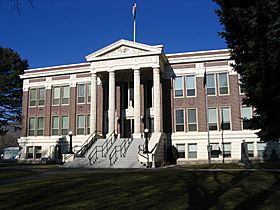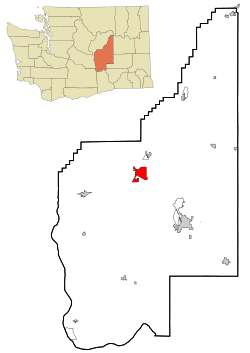Ephrata, Washington facts for kids
Quick facts for kids
Ephrata, Washington
|
|
|---|---|

Grant County Courthouse in Ephrata, pictured in 2008
|
|

Location of Ephrata, Washington
|
|
| Country | United States |
| State | Washington |
| County | Grant |
| Government | |
| • Type | Mayor–council |
| Area | |
| • Total | 10.44 sq mi (27.03 km2) |
| • Land | 10.44 sq mi (27.03 km2) |
| • Water | 0.00 sq mi (0.00 km2) |
| Elevation | 1,276 ft (389 m) |
| Population
(2020)
|
|
| • Total | 8,477 |
| • Density | 779.61/sq mi (301.00/km2) |
| Time zone | UTC-8 (Pacific (PST)) |
| • Summer (DST) | UTC-7 (PDT) |
| ZIP Code |
98823
|
| Area code | 509 |
| FIPS code | 53-22080 |
| GNIS feature ID | 1512192 |
Ephrata ( ee-FRAY-tə) is a city in and the county seat of Grant County, Washington, United States. Its population was 8,477 at the 2020 census.
Contents
History
Ephrata was officially incorporated on June 21, 1909 and was given the county seat for the newly created Grant County.
Historically, the settlement of Ephrata is quite recent. There was no known settlement until 1886, just three years before Washington attained statehood. The horse rancher Frank Beezley was the first to settle near the natural springs, thus the area was known as Beezley Springs. As the climate and topography were not promising to settlement, the entire region remained sparsely populated until several federal congressional actions, including the Northern Pacific Land Grant Act, the Homestead Act, and Desert Claims Act, encouraged the settlement of this semi-arid desert. Originally, Douglas County spread over the entire territory of the Big Bend of the Columbia River. In 1909, the Washington State legislature divided it, creating Grant County. When the time came to present arguments to the state legislature regarding which town should be the county seat, someone apparently intentionally intoxicated the representative of a rival community, and Ephrata was chosen.
It is generally believed that the city was named Ephrata by a man who worked for the Great Northern Railway. The name Ephrata is derived from a biblical description of an orchard in the middle of the desert. It is also the ancient name for the town of Bethlehem.
The region was known at the turn of the century for the great herds of wild horses that roamed the land. Horse trading was an important element of the local economy, and Ephrata served as the staging area for the horse round-ups. The last "Grand Horse Round-up" was held in Ephrata in 1906. Ephrata then developed as a trade and service center for cattle and sheep ranches in the area until the construction of the Columbia Basin Reclamation Project.
In 1939, one of the state's longest runways was built at Ephrata and served the U.S. Army Air Corps until 1945, when the field was turned into a commercial airport. The airport and hangars were used in Steven Spielberg's 1989 film Always, the final movie of Audrey Hepburn. It was used for the airport scenes for the fictional Flat Rock, Colorado.
In January 2011, Jim McCullar bought his half of a $380 million Mega Millions lottery ticket at a Safeway supermarket in Ephrata. It was the second largest jackpot in U.S. lottery history.
Grant County Public Utility District has its headquarters located in Ephrata.
Columbia Basin Irrigation Project
Beginning in July 1918, several prominent Ephrata residents started the promotion of a plan to redirect waters of the Columbia River in order to irrigate the dry but fertile soils of the Big Bend country. Labeled "The Dam University", Ephrata residents persistently lobbied at the local, state, and federal levels to gather support for the project. Initial funding for the Grand Coulee Dam was through the Public Works Administration created under Franklin Roosevelt's promise of a "New Deal" in 1933. However, the irrigation waters would not be released as the nation focused on ending World War II during the 1940s. During this era, Grand Coulee Dam's main mission was to produce electricity for the Hanford Reservation and for aluminum manufacturing, vital to military aircraft production. When the war ended, the Project returned to its original mission, to irrigate the desert.
Population growth
The construction of the Irrigation Project and the military activity increased the population of Ephrata by a factor of eight between 1940 and 1960. As the federal projects phased out, the town experienced a population decrease of 22% between 1960 and 1975. The population stabilized between 1975 and 1982, with a slight decrease between 1980 and 1990. The city has seen steady population growth since 1990. The present population is 7,110.
Geography and climate
Ephrata is located at 47°19′1″N 119°32′53″W / 47.31694°N 119.54806°W (47.316971, −119.548059).
According to the United States Census Bureau, the city has a total area of 10.09 square miles (26.13 km2), all of it land.
Link to local weather information from the NWS Spokane Office (National Weather Service) – http://www.wrh.noaa.gov/otx/
Ephrata experiences a semi-arid climate (Köppen BSk).
| Climate data for Ephrata, Washington | |||||||||||||
|---|---|---|---|---|---|---|---|---|---|---|---|---|---|
| Month | Jan | Feb | Mar | Apr | May | Jun | Jul | Aug | Sep | Oct | Nov | Dec | Year |
| Record high °F (°C) | 61 (16) |
65 (18) |
75 (24) |
94 (34) |
101 (38) |
107 (42) |
109 (43) |
115 (46) |
106 (41) |
86 (30) |
72 (22) |
63 (17) |
115 (46) |
| Average high °F (°C) | 34 (1) |
42 (6) |
54 (12) |
64 (18) |
73 (23) |
81 (27) |
88 (31) |
88 (31) |
78 (26) |
63 (17) |
45 (7) |
34 (1) |
62 (17) |
| Average low °F (°C) | 22 (−6) |
27 (−3) |
33 (1) |
40 (4) |
48 (9) |
55 (13) |
61 (16) |
60 (16) |
51 (11) |
40 (4) |
30 (−1) |
23 (−5) |
41 (5) |
| Record low °F (°C) | −22 (−30) |
−24 (−31) |
2 (−17) |
22 (−6) |
28 (−2) |
33 (1) |
40 (4) |
36 (2) |
28 (−2) |
8 (−13) |
0 (−18) |
−15 (−26) |
−24 (−31) |
| Average precipitation inches (mm) | 0.83 (21) |
0.78 (20) |
0.75 (19) |
0.43 (11) |
0.64 (16) |
0.51 (13) |
0.44 (11) |
0.25 (6.4) |
0.37 (9.4) |
0.47 (12) |
1.03 (26) |
1.19 (30) |
7.69 (195) |
| Source: The Weather Channel | |||||||||||||
Demographics
| Historical population | |||
|---|---|---|---|
| Census | Pop. | %± | |
| 1910 | 323 | — | |
| 1920 | 628 | 94.4% | |
| 1930 | 516 | −17.8% | |
| 1940 | 951 | 84.3% | |
| 1950 | 4,589 | 382.5% | |
| 1960 | 6,548 | 42.7% | |
| 1970 | 5,255 | −19.7% | |
| 1980 | 5,359 | 2.0% | |
| 1990 | 5,349 | −0.2% | |
| 2000 | 6,808 | 27.3% | |
| 2010 | 7,664 | 12.6% | |
| 2020 | 8,477 | 10.6% | |
| U.S. Decennial Census 2020 Census |
|||
2010 census
As of the census of 2010, there were 7,664 people, 2,856 households, and 1,915 families residing in the city. The population density was 759.6 inhabitants per square mile (293.3/km2). There were 3,086 housing units at an average density of 305.8 per square mile (118.1/km2). The racial makeup of the city was 84.1% White, 0.8% African American, 1.1% Native American, 1.3% Asian, 0.1% Pacific Islander, 9.5% from other races, and 3.1% from two or more races. Hispanic or Latino of any race were 16.7% of the population.
There were 2,856 households, of which 36.1% had children under the age of 18 living with them, 49.6% were married couples living together, 12.6% had a female householder with no husband present, 4.8% had a male householder with no wife present, and 32.9% were non-families. 28.7% of all households were made up of individuals, and 12.7% had someone living alone who was 65 years of age or older. The average household size was 2.57 and the average family size was 3.14.
The median age in the city was 34.7 years. 27.4% of residents were under the age of 18; 9.4% were between the ages of 18 and 24; 25% were from 25 to 44; 23.6% were from 45 to 64; and 14.6% were 65 years of age or older. The gender makeup of the city was 49.7% male and 50.3% female.
Transportation
- Ephrata (Amtrak station)
- Ephrata Municipal Airport
Notable people
- Ken Dow, professional American football player
- Thomas Jesse Drumheller, lawyer and sheep rancher
- Shane Johnson, actor
- Robert K. Preston, helicopter pilot and perpetrator of 1974 White House helicopter incident
- Bobby Rich, radio broadcaster
- Baxter Ward, TV news anchor
- Jim Wickwire, mountaineer and lawyer
See also
 In Spanish: Ephrata (Washington) para niños
In Spanish: Ephrata (Washington) para niños

